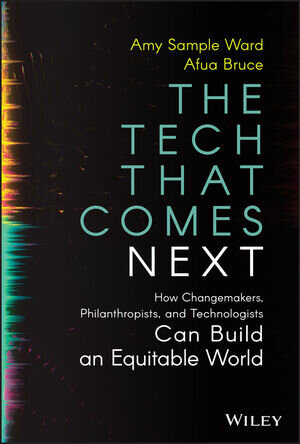The Tech That Comes Next: How Changemakers, Philanthropists, and Technologists Can Build an Equitable World
As technological innovation continues to accelerate, it runs the risk of leaving behind those in the social impact sector seeking to do good with it—unless key stakeholders come together to ensure that it is accessible and equitable. In The Tech That Comes Next: How Changemakers, Philanthropists, and Technologists Can Build an Equitable World, Amy Sample Ward and Afua Bruce explore how technology—which in itself is neither good nor bad nor even neutral—can best be utilized to change the world for the better. The authors, leaders in research and advocates for equitable design in technology, invite readers to rethink nearly every aspect of technology as it relates to philanthropic work and vice versa; while technology may not, currently, work in service of social impact movements, it doesn’t need to be that way. We can alter our thinking and make technology a powerful force for positive change.
Ward and Bruce open the book with a comprehensive acknowledgment section. Their recognition of the unceded Indigenous lands upon which they wrote this book sets the tone for the pages that follow. A core theme throughout The Tech That Comes Next is that any social impact innovation—whether it be technological, strategic, or otherwise—must involve, from start to finish, the active participation of the clients it hopes to serve.
From there, Ward and Bruce briefly discuss their backgrounds, and what has driven them to champion this work. Ward is the CEO of NTEN, an organization dedicated not only to supporting philanthropic work through the use of technology but also to advocating for technology to be more equitable, particularly in the nonprofit sector. Bruce is a public interest technologist who has spent her career at the intersection of private technology companies, public policy-making institutions, and NGOs. Both have seen the incredible potential of technology to drive social impact work—as well as the many pitfalls that have come with the traditional ways it’s been implemented.
“An equitable world is one where everyone has access to affordable, healthy food, a secure place to live, and the freedom and safety to pursue a life filled with loving relationships, joy, expression, and learning,” they write. “Equitable technology includes the networks, hardware, software, and services that support everyone’s access to, participation in, and fulfillment in an equitable world.” Ward and Bruce emphasize that they are not trying to dictate that their suggestions are the only viable path toward technology equity inside and outside the nonprofit sector; rather, they intend The Tech That Comes Next to be a jumping-off point from which key social impact stakeholders might explore what can be done with technological innovation.
Those key stakeholders span five categories: social impact organizations, defined as 501(c)(3) organizations and their international counterparts (although the authors are quick to state that this is a limiting category that excludes many other types of groups doing social impact work); technologists, defined as anyone developing technology, whether in the private, public, nonprofit, or academic sectors; funders, perhaps the broadest category, defined as anyone who donates money to social impact work; policy makers, which here includes anyone in a position to create policies that impact technology, social impact work, and all the places they intersect; and communities, very nebulously defined, but essentially those served through by social impact organizations. The bulk of the book is comprised of five chapters that each speak directly to one of those categories.
Each of these chapters showcases real-life examples of members of the aforementioned five categories of stakeholders who have rethought their approaches to the intersection of philanthropy and technology: a nonprofit that invested in and prioritized expanding its technical capabilities early on to rapidly expand the reach of its programs; a technologist that reached out to a college to identify a problem in the community and collaboratively used technology to find a solution; a funder who chose to give not only money but also the often overlooked time and expertise needed to make any new technology truly viable; a coalition of digital inclusion advocates that greatly influenced the passing of the Digital Equity Act; and communities around the world who have made themselves and their practical, lived experiences available to the organizations, technologists, funders, and policy makers who serve them. Again, the point of these examples is not to proscribe the specific way that this work should be done, but rather to show the potential that can come from reimagining technological innovation in the nonprofit landscape.
Ward and Bruce are quite dedicated to facilitating conversations about technology and social impact work. Not only does The Tech That Comes Next provide case studies as practical, real-life examples, but each chapter focused on one of the key stakeholder categories ends with discussion questions to help kickstart those conversations. One of the biggest issues the authors identify in their introductory chapter is how siloed the work being done by each of these stakeholder categories is; through these discussion questions, they encourage collaboration between parties, which has been largely overlooked in the past yet is absolutely necessary for initiatives involving technological innovation to succeed in the nonprofit sector.
This spirit of collaboration is at the nexus of the book’s thesis. In the first and second chapters, Ward and Bruce share two illustrations. In the first, we see the current nonprofit landscape that has resulted from social impact workers, technologists, funders, policy makers, and communities performing their work separately from one another—a “state of systemic exclusion.” “What if we could restructure how we think about developing systems and services to move beyond this picture and truly exist in a world where humans are centered and justice is pursued?” the authors ask.
In the second illustration, we see where Ward and Bruce hope to take us: a world where the people served by social impact organizations and the technology that powers them are “not only present but active participants shaping and enjoying their lives.” Their guiding questions all serve to break down barriers in communication between the stakeholders sitting at the intersection of philanthropy and technological innovation so that all parties can contribute their expertise and create, together, technological solutions to social impact issues that are greater than the sum of their parts.
There is, of course, one hitch, which Ward and Bruce duly acknowledge: For their theory to work, it requires total buy-in from all individuals and groups involved. Social impact organizations will need to identify technology as a programmatic priority and invest time and energy into it appropriately; technologists will need to accept that every nonprofit—and every issue they work on—may need specialized, customized technological solutions. Funders may have to wait far longer than they’re used to for a truly inclusive development process to see returns on their investments; policy makers will need to actively solicit the expertise of others in both private and public sectors to fill the gaps in their own knowledge. Most importantly, the communities being served by these other players must be consulted and actively participate in every step of the process. Whether the possibility for such harmony currently exists in our fractured world remains to be seen—but at least with The Tech That Comes Next, we have a vision of what it may look like.
Audrey Silverman is a fundraising professional working in the Jewish nonprofit sector.







